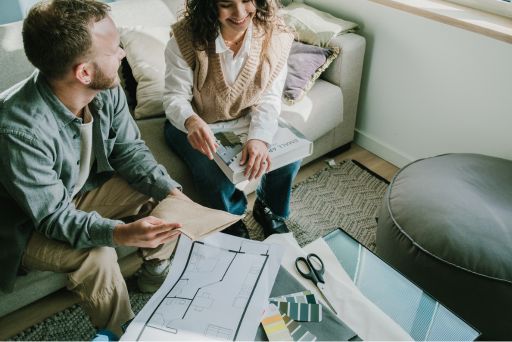Effective accounting for interior designers is crucial for maintaining a successful interior design business. Understanding and managing your finances not only ensures compliance with tax laws but also allows you to make informed decisions that drive your business growth. This comprehensive guide covers the essential aspects of accounting tailored specifically for interior designers.

Why is Bookkeeping Important for Small Businesses?
While your expertise allows you to design stunning interiors, effective bookkeeping is crucial for optimizing the “interiors” of your business. Proper bookkeeping can significantly enhance the profitability of your interior design firm. Here’s how:
1. Grabbing Tax Deductions
Meticulous bookkeeping involves segmenting and categorizing every expense, allowing you to identify transactions that are eligible for lower tax rates or exemptions. Without diligent bookkeeping, you would miss out on these tax deductions, resulting in higher tax payments and lost savings.
2. Budgeting Your Finances
Good bookkeeping enables small businesses to budget efficiently and accurately. By tracking, segmenting, and organizing all income and expenditures, you can plan effectively for the future. A well-structured budget sets your firm up for success and helps avoid unexpected financial hurdles caused by instability or poor planning.
3. Analyzing the Intricacies of Your Firm
Bookkeeping allows you to analyze your business in ways you might not have thought possible. By examining historical data, you can understand where your business is headed and how it performs over time. Analyzing your firm’s financial statements helps you identify financial mistakes or inaccuracies, such as underbilling or overpaying for services. Additionally, you can accurately pinpoint the seasonality of your business, allowing you to capitalize on peak periods and improve decision-making regarding operations and finances.
4. Getting Business Loans
For small businesses, securing business loans is essential for growth and expansion. Banks are often hesitant to lend to small businesses due to perceived higher risks compared to medium or large enterprises. However, accurate and timely financial statements generated through bookkeeping can improve your chances of securing loans and potentially at lower interest rates.
5. Generating Reports
If you have investors, they will likely request financial reports to assess the health of your business. Effective bookkeeping allows you to generate transparent and accurate reports for investors. Even without current investors, generating these reports can be advantageous for attracting future stakeholders who will want to make informed investment decisions.
The Accounting Process for Interior Designers
A typical accounting workflow for an interior design firm involves several key steps:
- Recording Transactions: Document all financial transactions, including client deposits, purchase orders, and employee salary payments.
- Classifying Expenses: Categorize business expenses into relevant accounts such as materials, labor, and overhead.
- Generating Financial Statements: Create financial reports such as balance sheets, income statements, and cash flow statements.
- Reviewing Financial Activities: Regularly review financial activities to ensure accuracy and compliance with tax laws.
Key Elements of the Accounting Process
- Expense Tracking: Accurately track expenses to avoid financial instability.
- Time Tracking: Monitor time spent on projects for accurate billing.
- Payroll Management: Handle payroll taxes and document employee salary accurately.
A Typical Accounting Workflow for a Bookkeeper at an Interior Design Firm
The accounting workflow in an interior design firm involves several crucial steps to ensure smooth financial management. Here’s a detailed look at what this workflow might include:
1. Invoicing Clients
The process begins with invoicing once a proposal for a design or item is approved by the clients. This invoice covers the cost of goods or service fees.
2. Recording Payments and Managing Invoices
Upon receiving the payment, the bookkeeper records it. If the payment is outstanding, it is marked for collection.
3. Creating Purchase Orders
Based on the paid client invoices, purchase orders should be promptly created to ensure the timely acquisition of necessary goods and services.
4. Recording Payables
The next step is to record any payments owed by the company or by clients to contractors, suppliers, and other parties. This includes tracking both direct dealings and intermediary transactions.
5. Issuing Payments
Payments owed to suppliers, vendors, and contractors need to be issued and recorded systematically to maintain clear financial records.
6. Documenting Employee Salaries
Documenting employee salaries and payments should be done regularly to ensure accurate payroll management.
7. Handling Payroll Taxes and Deductions
Accurate recording and assistance with payroll taxes and deductions are essential to comply with legal requirements and to ensure proper tax filings.
8. Monitoring Financial Activities
A meticulous tab on financial activities is maintained using project management systems. This helps in preparing detailed financial reports.
9. Reconciling Bank Statements
Bank statements should be reconciled in real-time to ensure all transactions are accounted for accurately and to prevent discrepancies.
10. Assisting with Taxes and Turnovers
Finally, the bookkeeper assists the accountant or CPA by providing necessary records and information, facilitating accurate tax filings and turnover reports.

15 Bookkeeping Tips for Interior Designers and Firms
1. Choosing How to Keep the Books
While using cheque books might seem straightforward initially, it is neither always viable nor efficient for a growing business. Planning how to maintain balance sheets and prepare financial statements is crucial. Programs like MS Word and Excel are often inadequate for growing businesses, but many affordable accounting software options are available for business owners to manage expense tracking and accounting effectively.
2. Keep Time
It’s easy to lose track of time and forget to log hours spent on a project, which can cost the firm money. Keeping meticulous records of the time spent on projects is essential for accurate client billing. Implementing a company policy that mandates logging hours can prevent underestimating time, especially when working offsite.
3. Day-to-Day Bookkeeping
Efficient bookkeeping tracks transactions, bank statements, debit and credit card statements, purchase orders, and payroll statements, helping organize all income and expenditures. This not only aids in future planning but also helps small businesses budget properly and avoid financial instability. Regular bookkeeping allows you to analyze your firm’s performance over time, identify financial mistakes, and spot seasonal profit trends, leading to improved operations.
4. Maintain Detailed Records
Once recorded, it is vital to store all documentation in an organized and accessible manner, which is made easier with cloud backup services. This allows you to track your company’s finances and progress over the years. You might also need these receipts and proofs of transactions for your CPA or during potential audits.
5. Procurement and Purchasing
During a project, it can be challenging to keep tabs on bookkeeping. However, using purchase orders is essential. They help catch errors, allocate expenses, and fast-track invoices. Failing to follow up on purchase orders can delay projects and cause incorrect billing of clients. Clear and systematic communication with vendors, prompt creation of purchase orders, processing payments, and tracking order status are all vital for efficient bookkeeping.
6. Start Logging Activities
Given the numerous steps involved in each project, it makes sense for interior designers to track every process methodically. Regularly logging activities such as proposals, time billing, invoices, sales, and payments ensures a clean and detailed record, aiding the bookkeeping process. At a minimum, a weekly log is recommended for even small businesses.
7. Working with Deposits
It’s advisable to hold off on client purchasing until you receive payments from clients. Using company money should be avoided in case an order is canceled or a client rejects an item. Any changes in proposed prices must be promptly reflected in deposits and invoices. Breaking projects into phases helps keep bookkeeping and deposits organized.
8. Getting Business Loans
Updated and reliable financial statements can help small interior design businesses secure bank loans. Accurate bookkeeping records give banks confidence in your company’s stability, allowing you to take advantage of various loan schemes.
9. Track Recoverable Expenses
Tracking recoverable expenses is essential to save the company money. Expenses like travel during a project or site visit can be billed to the client and reimbursed. Effective bookkeeping ensures these expenses are recorded accurately, preventing them from cutting into company profits.
10. Sales Tax Filings and Government Reporting
Tracking sales tax and income tax, and submitting filings in a timely manner keeps your company compliant and avoids defaults. Complying with government regulations, including payroll taxes, is critical. Monthly or quarterly reports facilitate tax filings.
11. Grabbing Tax Deductions
Diligent bookkeeping can help you identify areas where you can avail of tax deductions or rebates on purchases and transactions. Timely and organized accounts will help the firm save money and boost profits.
12. Generating Reports
Regular and updated financial statements are beneficial for interior design firms. Investors and stakeholders demand transparent reports of transactions and the company’s financial growth, which can be provided through accurate financial reporting. These reports can also attract new investors by showcasing the company’s financial stability and growth potential.
13. Be Consistent
Although it may seem tedious, it’s necessary to create a schedule for regular bookkeeping activities and adhere to it. Consistency is key to effective and precise bookkeeping. This helps your firm stay on top of expenditures and profit margins, and keeps clients informed of new costs, exceeded budgets, and remaining expenses, reducing risks and surprises.
14. Personal and Business Account
It is essential to keep your personal and business finances separate. Using personal debit or credit cards for business transactions, or vice versa, can lead to missed tax deductions and reimbursement errors. Keeping separate accounts ensures clean bookkeeping free from personal transactions.
15. Client Account
Consider taking it a step further by keeping a third account specifically for client deposits. This ensures that only profits or final income are reflected in the company account, preventing accidental spending of funds on other projects or personal expenses.

Conclusion
Accounting for interior designers involves a comprehensive understanding of financial management, from bookkeeping to financial reporting. By using the right accounting software and maintaining meticulous records, interior design firms can ensure financial stability and focus on delivering exceptional design services. Regularly reviewing financial activities, managing cash flow, and preparing for tax season are key practices that contribute to the overall success of an interior design business.


